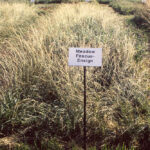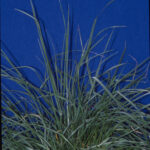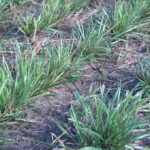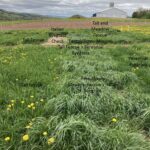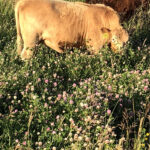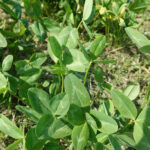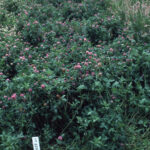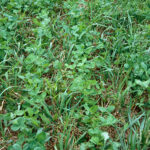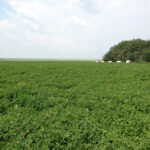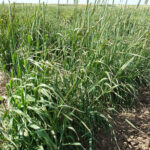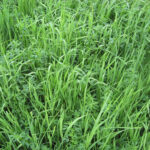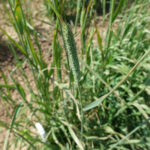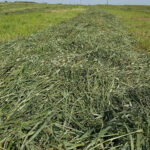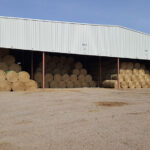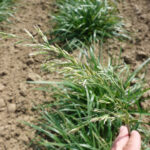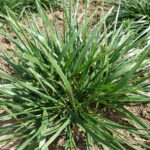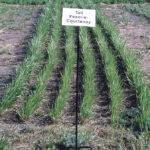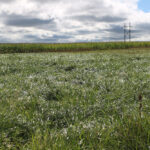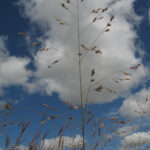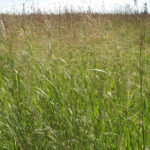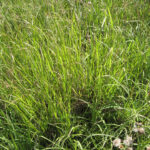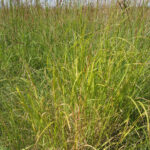Meadow Fescue
General Description
Meadow fescue is a perennial bunch grass suited to higher precipitation areas, but lacks longevity due to poorer winter hardiness and susceptibility to heavy grazing. It is very closely related to tall fescue, and can be hard to distinguish. Generally, meadow fescue is less persistent, shorter, and finer leaved. It has the ability to cross with perennial and annual ryegrass.
Meadow fescue has bright green leaves with narrow, long (up to 50 cm (20 in) blades and sharp-pointed tips. Meadow fescue is a bunchgrass with short rhizomes that give it a weakly creeping habit. The sheath is split with the margins overlapping at the bottom. The blade is 3-8 mm wide and 10-50 cm (4-20 in) long, the upper side is dull and the lower side shiny. The edges are rough, and the tip is sharp-pointed. The collar is broad and continuous. The auricles are 0.5-1.5 mm long and usually blunt but sometimes claw-like. The ligule is a very short membrane. The stems are round and 60-125 cm (24-50 in) tall. The inflorescence is a slender panicle. Its most distinguishing features are rough leaf edges, short ligules and claw-like auricles. Meadow fescue is a non-jointing grass.
Type
Tame grass.
Origin
Europe.
Longevity
At least 3 years.
Use
Pasture, hay, silage, stockpiled. Meadow fescue is best used as pasture as growth is mainly basal.
Optimal Time of Use
Spring, summer, fall, winter. Meadow fescue has been replaced mainly by new tall fescue varieties that have equal adaptability and more production and longevity. Hay by heading. Meadow fescue is best rotationally grazed but can be continually with care.
Recovery After Use
If hayed, meadow fescue can be grazed or stockpiled thereafter. Leave at least 10 cm (4 in) for regrowth to occur. Good for summer grazing or stockpil¬ing for fall and early winter grazing as it maintains quality well after fall frosts.
Palatability/Nutritional Value
Meadow fescue has an average total digestible nutrient (TDN) level of 61% and crude protein level of 12.5% in the vegetative state. Meadow fescue has fair palatability. Meadow fescue remains green into the fall.
Drought Tolerance
Moderate tolerance. It is less drought tolerant than tall fescue.
Flooding Tolerance
Withstands 2-5 weeks of spring flooding. It withstands wet soils season long.
Winter Hardiness
Fair hardiness. Meadow fescue longevity is limited by winter hardiness.
Soil Texture Preference
Meadow fescue grows best on deep, fertile soils but will tolerate variable drainage and low fertility. It has a shallower root system, is shorter lived and is not as tolerant of poor conditions as tall fescue.
Erosion Control
Moderate erosion control. Can be used as an initial species in waterways or channels to prevent erosion as it does not impede water movement.
Salinity Tolerance
Moderate tolerance.
Acidity Tolerance
Moderate tolerance.
Alkalinity Tolerance
Low tolerance.
Seeds per kg
507,000 seeds/kg (230,000 seeds/lb).
Suggested Mixtures
Meadow fescue is compatible in mixes. Species include clover, alfalfa birdsfoot trefoil, timothy and bromegrasses.
Ease of Establishment
Meadow fescue seedlings can establish well in the first season when competition is managed. It is noted to winterkill easily during the establishment year. Seed a pure stand at a rate of 20–25 kg/ha (18–22 lb/acre) and a depth of 1 cm (3/8 in). In a mixed stand, reduce the seeding rate.
Competitiveness
Meadow fescue has moderate competitive ability. Overall, its longevity is limited with cold winter conditions.
Management Considerations
Allow for adequate rest following defoliation. Cold hardiness is its major limitation. May serve well as a short rotation, good producing grass species for late season grazing.
Saskatchewan Dryland Forage Species Adaptation Tool, USDA, Manitoba Forage Adaptation and Comparison Guide, Alberta Forage Manual, OMAFRA Publication 30
Meadow fescue is adapted to warmer and more wetter areas of the Sub-Boreal Spruce, Interior Cedar-Hemlock and Sub-Boreal Pine-Spruce zones. In the southern part of the region, meadow fescue is adapted to the wetter areas of the Interior Douglas-fir zone, and to irrigated and subirrigated areas in the Bunchgrass and drier areas of the Interior Douglas-fir zone.
Meadow fescue is adapted to the wetter parts of the Interior Douglas-fir zone, the Interior Cedar-Hemlock zone, and to irrigated and subirrigated areas in the Bunchgrass and Ponderosa Pine zones, and Interior Douglas-fir zone.
Meadow fescue has some adaptive characteristics suited to the Peace-Liard region, but only fair hardiness is likely to limit its use.

